Carreducker remote-fitted bespoke boots: Review
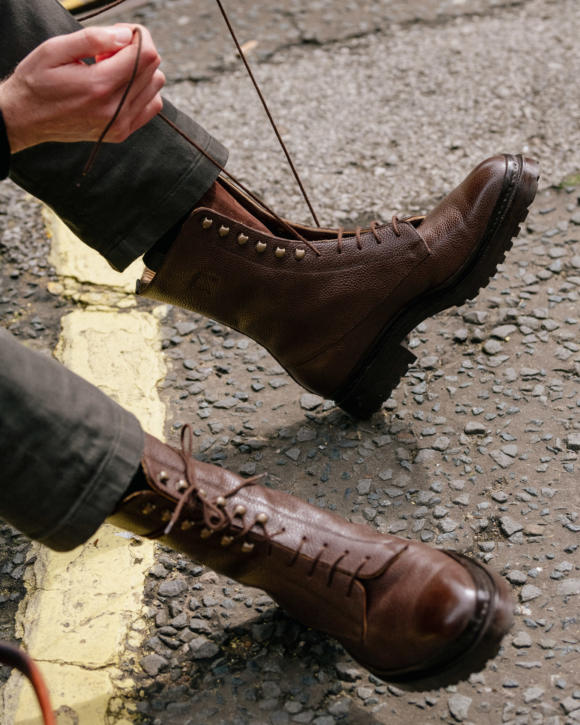
I think when craftsmen are doing remote fittings, they err on the safe side.
That’s one consistency I can draw from my online bespoke over the past year.
Whether it’s with WW Chan, Massura or Ferdinando Caraceni in tailoring, Carreducker, Carlino or Petru & Claymoor in shoemaking, or Stoffa in shirtmaking, they all seem to have stayed conservative.
In many ways that’s understandable. After all, with most clothes it’s easier to take them in than to take them out. Certainly with shirts and knitwear, and with shoes it’s easier to add an insole that it is to start stretching the upper.
My ‘bespoke manufactured’ boots from Carreducker, recently received and pictured here, are really lovely, and the only fit issue is a similar, slight roominess.
With a thicker sock, they’re perfect. There’s enough room to wiggle my toes around, and the heel is held firmly in place.
Avoiding heel slippage was the biggest challenge of the fitting, as my slim ankles mean the boot had to be cut quite close - but couldn’t be uncomfortable.
When I first got the boots I was worried the fit was much too loose, as the heel was slipping. But that turned out to be largely down to the stiff sole. Once that softened up a little - after a handful of walks - it stayed snugly in place.
I will wear the boots with thicker socks in the Winter, so the fit might be fine as it is. And they’re fantastically comfortable with a chunky cotton sock, and then all that quality calf and suede surrounding the foot on the inside.
Realistically, though, I haven’t worn the boots enough to tell. And if I do need them smaller, it’s simple to add an insole. I’ll make a decision when the weather turns cold again.
I mentioned suede surrounding the foot - that’s the long, bellowed tongue that runs up the front, and might even be my favourite part of the boot.
It’s very fine and soft, in contrast to the tough and rugged make elsewhere. And it’s lovely feeling that fold around the foot as you lace them up.
Some of my Edward Green boots have that feature as well, and it’s similarly pleasing. With the Carreducker boots it’s exaggerated because the tongue is so long. A bit like enjoying more material in an extra-long overcoat.
My initial reaction when I received the boots was surprise at how chunky they looked.
This is down to two things: the thickness of the sole and the height of the storm welt. The two build on each other, creating a tall dark barrier between the upper and the ground.
The sole is the same thickness as the example I picked, but appears thicker because I chose a dark rather than mid-brown edge. The storm welt, however, is definitely taller.
This I hadn’t seen during the fitting process, as the welt wasn’t attached, and James says he tried it as a style point that could easily be reduced later. As the stitching as it at the bottom, it’s fairly simple to cut off a strip from the top.
I quite like the welt height though.
It’s certainly not disproportionate to the rest of the boot, given its height. And it looks practical and only a touch unusual.
Still, I might have to trim it a little for another reason, which is that when I wear the boots there is a small gap in places between the top of the welt and the upper. This undermines the water resistance rather, as rain would get into that gap.
James had foreseen this might be a problem, but until the wearer has their foot in the boot and so pushes the upper out, it’s impossible to know whether that will close the gap. Mine doesn’t, quite.
In places, even with thick socks on, the boots do lace up completely, with no gap between the facings on either side.
This is normally something you want to avoid, because as the leather softens with wear, those facings will want to go a little closer to maintain the same fit.
But actually, I find this happens much less with bespoke shoes than with ready-made.
The reason, another bespoke maker told me, is that a RTW shoe never fits precisely and so has little gaps in places between the foot and the shoe. It is these that close up as the upper softens and fits more closely to the foot.
A bespoke shoe should fit more closely, and so doesn’t have these little gaps. Hence less change to the lacing over time.
The Carreducker boots are generally well made. The only thing I would pick up is the stitching along the storm welt, which in one or two places could be more precise.
James held his hands up to this, and agreed it could be straighter. Going through the welt and the upper like this is not easy, and with handwork some variation is inevitable. But it’s still something that could have been better.
It’s also worth bearing in mind that Carreducker’s style is not the same as other, finer and dressier makers. While not necessarily excusing that welt stitching, James’s aesthetic is generally of a functional, strong shoe, more akin to his former employer John Lobb than say Daniel Wegan or Yohei Fukuda.
A comparison with those makers on making points wouldn’t be fair.
The boots were made under what Carreducker calls its ‘Bespoke Manufactured’ system. They are bespoke in every way, except that the sole is sewn by machine.
They were also measured and fitted remotely - James and I did not meet face to face - and they were my first pair of shoes from Carreducker. There was no existing last.
It’s worth repeating that the fit was good, and particularly good given this remote process.
You can read more about these approaches from Carreducker, as well as many others they offer, on our introductory article here.
These boots cost £660 for the lasts (a one-off cost), £1745 for the make, and an extra £200 for being boots (more materials, more work). Total £2605 (including VAT).
The olive-green chinos are from Blackhorse Lane. On which more soon.
Photography: Alex Natt @adnatt


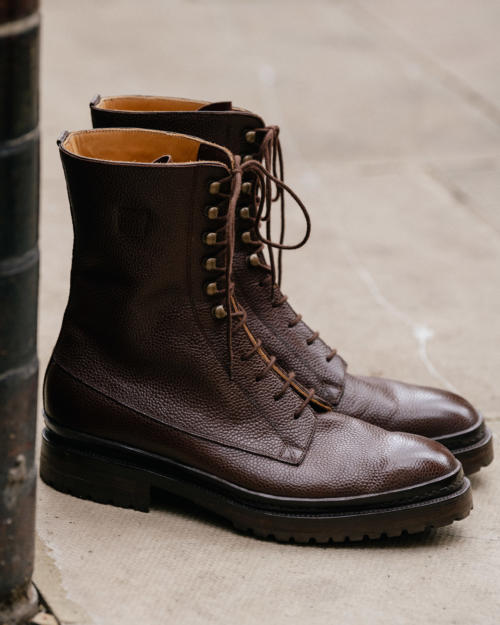
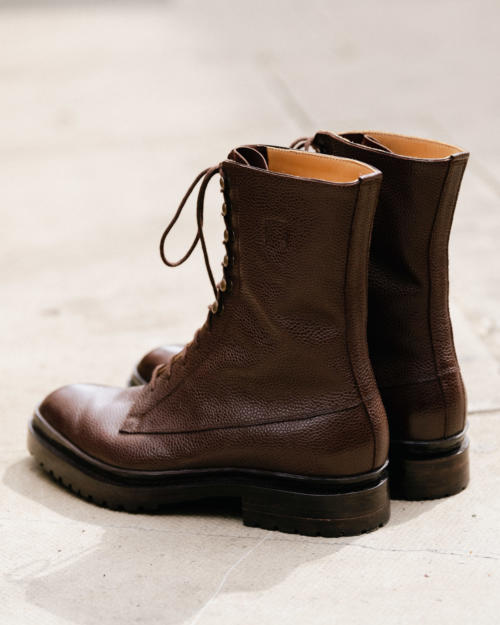
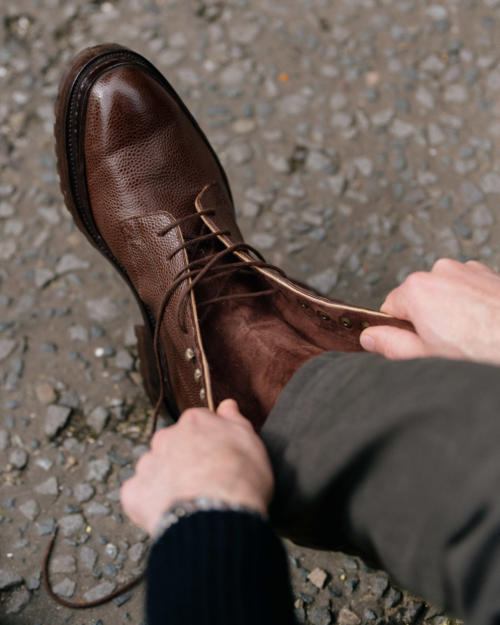
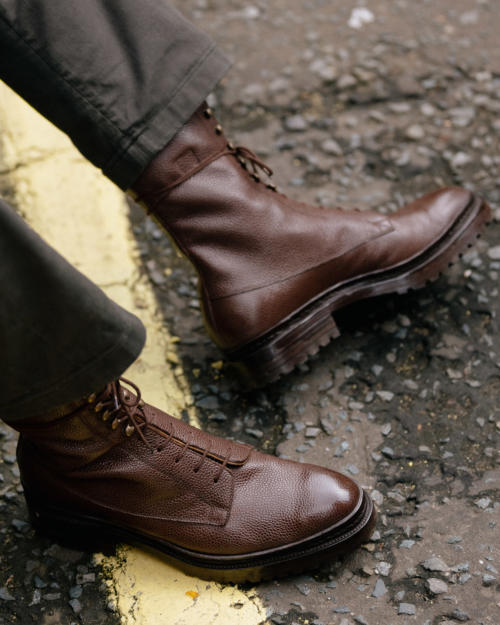
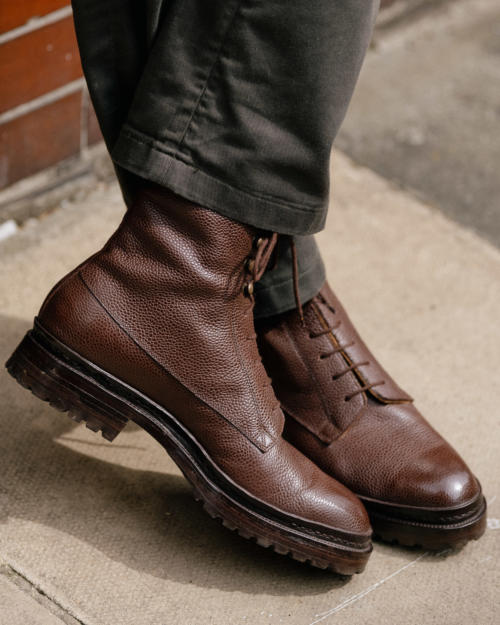
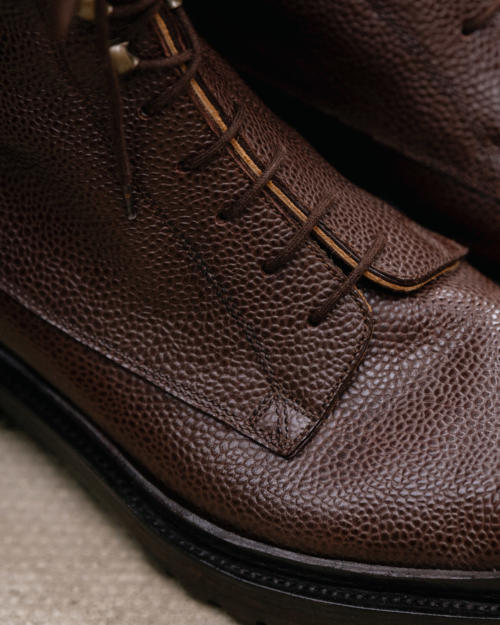
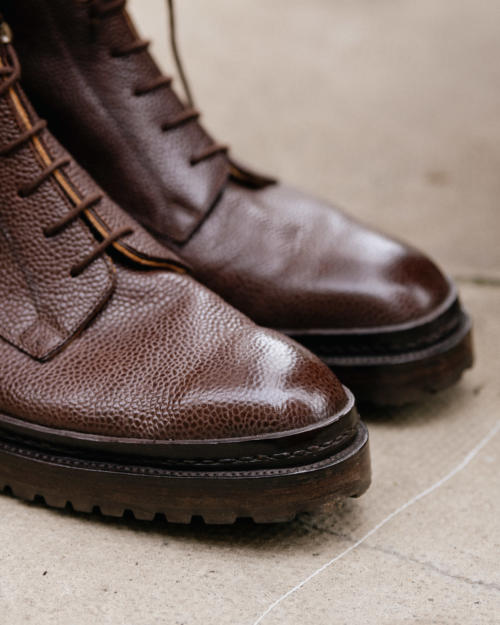
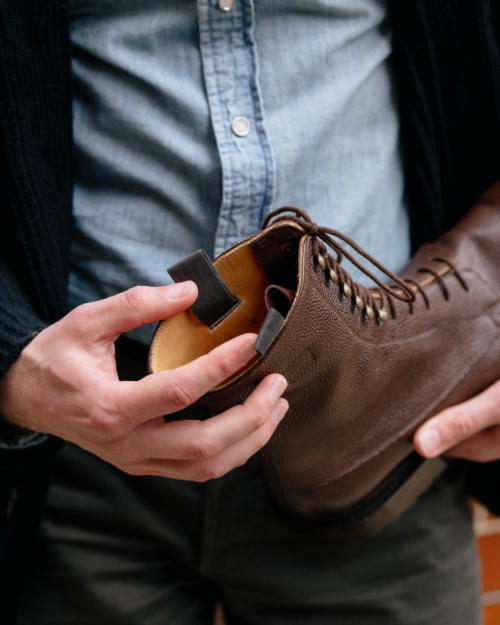

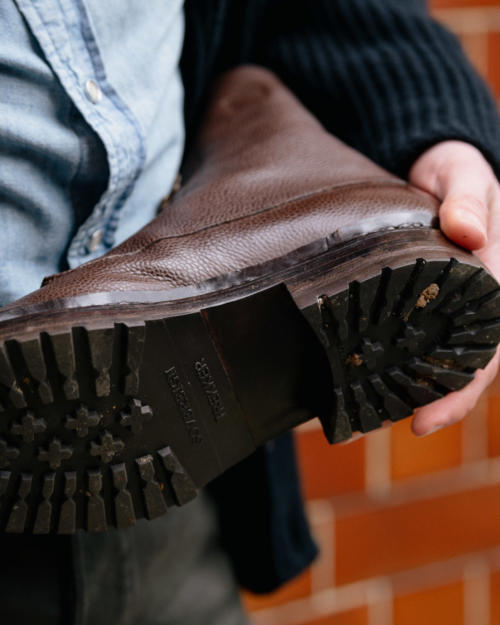


























Simon, I have been looking for a solid pair of hiking boots lately and find myself conflicted. On the one hand, I aesthetically adore boots like these and C&J Storm Welts for instance, but question if they would be best suited for long, arduous hikes. I suppose they are perfect for the odd jaunt in the country, but that aside, can they ever match a pair of technical hiking boots in terms of fit and comfort? Keen to hear others’ experiences.
Hi Martin,
I think the truth, unfortunately, is that they can’t. I haven’t recently, but certainly in years gone by I have tried to use traditional boots like these, as well as Aldens and work boots like my Wolverines, and while they’re fine for a while, and both comfortable, tough and pretty waterproof, they’re not built for long, arduous hikes, as you describe. They’re walking boots in the end, not hiking ones. Leisurewear, not sportswear.
S
Although I should also add that, again in my experience, work boots like these recently covered from Viberg are better in this regard than most Northampton boots.
Cheers Simon. I suspected so, but reckon I’d end up buying them anyway. To digress, I discovered very recently on a trip to Crete that in fact there are still people who use traditional Cretan boots (similar to wellies) as a way of daily life. Although these days, they are largely constrained to ceremonial use, I was told by the maker that there are still a relatively small minority of farmers who use it for their daily work. The overall demand unfortunately is dwindling by the day, but I thought of sharing this in case anyone is interested. Each pair is bespoke and made by hand.
http://gilotes-stivania.gr/en/home
Amazing Martin, I’d never heard of them. Thank you
Martin, I have much more experience of the hiking style than I do of more ‘stylish’ boots and you definitely need to get a good pair of proper boots designed or walking. If you prefer a leather, more traditional looking boot there is a company in the UK Altberg who also do a fitting service. https://www.altberg.co.uk/boots/hiking-boots13
Thanks Kev – much appreciated.
I can second Altbergs. I’ve only bought off the shelf but they are a good-looking, traditional and highly functional leather boot. Mine have taken me up Scottish Munros and on treks in Nepal. Superb boots, resoleable and made in UK or Italy if that means something to you.
Martin, I wear both work boots, Northampton-made and Aldens, and do a bit of up- and downhill hiking. I’ve tried both Alden and Viberg on trail hikes and they cannot compete with a the full-leather Asolo backpacker boots I wear for technical hikes — with most of the good technical boot brands, make sure to look at the different quality grades. Asolo, for instance, have a lot of cheaper models made in China in which the leather will never soften and grip your ankle properly. The higher-end lines claim to be made in Italy, though I suspect mostly made in Romania and finished in Italy, but they’re miles better for serious trail walks.
Thanks Michael. V useful to know.
I’m not sure if you would agree Michael as I’m probably not as experienced with these, but I’ve really been enjoying my Hanwag Tashi hiking boots, fully stitched construction with yak leather which has been super soft and didn’t need any break-in but feels very solid. They make other stitched models such as the Bergler if one prefers tougher leather.
Altberg are, I believe, also the manufacturer of standard issue British Army boots.
Their leather trail shoes are excellent. Perfect for most uk conditions and ,if you add ankle gaiters, suitable for most uk conditions bar the Scottish mountains.
Simon, you often mention your narrow ankles, if you progress to higher ground as your kids grow, altberg are very narrow in the heel.
Pre-COVID they did offer full bespoke for their boots.
Super, thanks Peter, good to know
Peter, I have been looking for a good pair of gaiters and have not been able to find any online. Any suggestions? Thanks in advance
Mine are Salewa. Most of the uk outdoor clothing shops have them. Black Mountain also have a good reputation.
I find they take a great deal of punishment, so I avoid high spec technical gaiters i.e gortex.
Excellent – thanks Peter
This seems to have a nice cleated sole, Simon and looks in keeping with the boot style.(Perhaps a shot of the sole would have helped here?) It appears to me this is something that lies in the form vs function spectrum. If you are wanting a more substantial boot for inclement days in the town then maybe the more substantial offerings from Edward Green etc are suitable. Then again would you want to expose expensive, stylish footwear to the wet, grit etc on a country walk? go over to the functional side someone wanting a very stable, waterproof boot for rougher places will probably compromise a bit of style or forgive slightly wonky stitching if the boots do the job. (I recall similar observations from yourself when describing the design details for the waxed type of jacket, if that is a fair comparison?)
Yes, I think that’s fair Kev. I think also, that this style of footwear will suit some readers more, that perhaps dress more day-to-day in casual things like chinos and jeans than flannels and worsteds. They have that rugged practicality, yet refinement in the make and materials.
I’ll see if I have a photo of the sole.
I have a partial shot of the sole Kev, added now at the bottom of the post
Thank you, Simon. Looks like a good, solid Vibram style and what you’d expect. with this style.
Re socks, do you wear OTC or crew socks? I don’t think I’ve ever found any thick wool or cotton OTC socks but I’d worry about crew length slipping down and bunching.
I think if I were to ever get boots this tall I would definitely need them bespoke due to my calves annoyingly! Perhaps a good excuse though, in the future.
Yes, calves and slim ankles are a good reason for me too. Boots like this are always too big in those areas.
I wear OTC socks with these, and there are plenty around. The ‘super-durable’ wool versions at MCR would be a good option, for example.
And there are thicker ones for hunting etc there too.
I’ve got a few pairs from around the place (Falke always have them), but the best ones I’ve found for a thick rugged look are military surplus. There’s plenty of olive-green out there, but other traditional military colours too, if you’ve got the time to go trawling eBay and the like.
Lovely looking boots. Is the instep too high? The lacing is completely closed. With wear, is there a danger that the quarters (?) will overlap?
Probably not – I talk about that in the article. Read the section beginning “In places…”
Hi Simon, Great article. Do you have a preferred insole for dress shoes/boots?
Thank you
Hey PM – no, not really. I haven’t actually used one in a while. But in a case like this I would get the manufacturer to put one in, underneath the leather sock of the boot, so it wouldn’t be touching my foot anyway and I’d rely on them to use the type they thought best.
You mention in your comment to Martin that the boots are “pretty waterproof”. Is the leather upper more waterproof than other leathers? It looks to me that you used a pebble grain leather–is that true of all pebble grains?
I’m interested in which leathers are best for bad weather (rain, snow, sleet). My understanding is that oiled leathers are the most waterproof, and cordovan is reasonably waterproof as well.
There are a few aspects to being more or less waterproof.
One is the height of the sole and welt, which here are pretty substantial. That stops quite a lot of water coming up from the ground, whether wet earth or puddles on pavements, onto the upper.
Another is the way the tongue is made. If that’s a bellow tongue, as this is, where the tongue is attached all the way up the side of the boot, then that is good at preventing the water from getting inside the boot.
Then there’s the material of the upper. Yes, oiled leathers are good and so is cordovan. Grained leathers are not as good as those, but they are often better than plain calf because the texture means water tends to roll off them more easily, and not sit on the surface so much. A grain is also usually a coating on top of the leather, which helps too.
As discussed in our old article here though, suede is actually a very good choice for wet weather.
leather unfortunately is not waterproof. more waterproof than canvas sneakers but still not waterproof.
after couple hours in snow my trickers stows are soaking wet, commando sole, storm welt, bellows(?) thongue and all..
and leather shoes? water gets trough the upper quick enough…
in my opinion, “waterproof” shoes are waterproof only when rain is over and you don’t step in the puddles much… only way for leather to be waterproof is with waterproof treatment.. but that kind of defeats the purpose of natural, breathing material…
I guess it would be helpful to separate different conditions. Few people are probably wearing shoes like this for two hours in the snow.
For most, it’s a case of anything from 1 to 10 minutes at a time, between one building or station and another. And often with an umbrella or something else as well.
All of the things I mentioned are about mitigating water getting onto the upper. If you’re in rain or snow that long, no they don’t make any difference.
One thing to note, though, is also how the shoes recover from being wet. That’s the biggest advantage of suede – no salt stains, unlike leather.
I think this is particularly important because most of the time, for most guys, they just don’t need things to be ‘waterproof’. A little shower, and everyone puts on their Goretex, crinkly plastic waterproof coats, when they’d be absolutely fine in a wool coat – as long as they looked after it when they got somewhere. Just hang it up, let it dry naturally. And the material is beautiful, unlike any synthetic.
To that I agree. However it would be water resistant, not waterproof.
Yes, good point
Hi Simon, you mention shirtmaking from Stòffa, do you mind mentioning what piece you got from them? Will there be an article on that soon?
That’s actually a little out of date. We were going through the process of making an overshirt remotely, but it turned out the fabric I preferred was out of stock, so it will have to wait for next year
I really like the style of the boots – very similar to Norman Vilalta derby boots (https://shop.normanvilalta.com/collections/mens-leather-boots-in-barcelona-spain/products/derby-simple-boot-dark-chestnut) or the G&G Urban Commando, aren’t they? I am not a fan of the high welt though, it seems a little gimmicky to me.
I do think they look visibly too large. The lacing is one aspect, but it also seems that already after minimal wear you got very pronounced creasing, somewhat destroying the silhouette of the boots (especially in the second last photo). From my experience, insoles don’t solve that problem. Reminds me a little of the Vass cordovan split toes you presented recently.
Hi Ferdinand,
Nice references, yes. I think they’re a little more rugged that those, but that’s probably largely down to the height and leather.
The lacing I don’t think is a factor – this is a hangover from RTW sizing rather than bespoke mostly – and of course larger socks or an insole would help there. But the creasing is certainly a factor and I’ll keep an eye on that.
I don’t think they’re really that similar to the Vass/Ascot pair, as those were over a size too big, and didn’t work even with two insoles in there!
Yes, you’re right – the Vass shoes were much worse in that regard. Still it’s a pity here because the last actually looks very cool, neither too elegant nor too sturdy, and the waves and double creases somewhat break that neat appearance. I find it surprising how when it comes to robust winter boots there are dozens of country boots, but barely anything like a refined combat boot, which looks much more modern. Maybe its time for the first PS collaboration on footwear…
Well, we did do purple slippers a very long time ago!
Purple combat boots!
So how did this develop – do you still wear them?
I do, yes, they’re lovely in the winter
They really look great. Nice and chunky, just the way such military boots should be.
A tip for breaking in such boots, especially if you have a slim ankle /lower calf and thicker socks don’t work, is to slip over a sports wrist band over the foot for the area where the boot rubs until softened & supple.
What a great tip, thank you Steve, I would never have thought of that